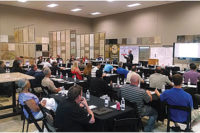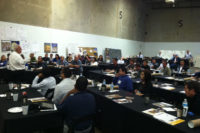Inviting fabricators from all over the area, MS International, Inc. (MSI) hosted the Stone Industry Education presented by the Marble Institute of America (MIA) and Stone World magazine. The event included a main presentation in the morning, networking opportunities, a warehouse tour and a Fabricator Forum, which provided an opportunity for attendees to discuss a number of industry topics. The event included 45 fabricators from 27 companies and 83 total participants.
GK Naquin of Stone Interiors North America started off the day with a presentation about analyzing shop performances from sales to production and measuring metrics. At the start of his presentation, Naquin asked how many of the fabricators have more than two crews going out a day to install. He followed up by asking how many square feet minimum each crew should set a day, with a response from fabricators of “100.” “That’s pretty much standard across the board,” said Naquin. “A crew should set about 100 feet a day. You may all have different types of schedules, but it all comes down to making sure your crews put down the proper amount of work that day and the proper location for the day, especially if you have four or five crews in different locations a day.”
Naquin went on to say that the most critical point is that the install work is done right and all the work is well communicated. “The most important thing is that the installer is well educated and good with communication,” Naquin said. “Our installers do a lot, and we train them how to handle different customer situations. One of the most important things our installers do is they carry a simple handbook. It’s the ‘MIA Residential Stone Countertop Installation’ handbook. It sits in every one of our installers trucks. The reason it sits in there is because when the customer says, ‘I don’t particularly like that gap in the cabinet and the granite,’ the standard for installation countertops is in that book. [The installer] pulls it out, and he is not just saying, ‘That is the standard in our industry,’ he is now showing it and he is showing it from a third party.”
In response, the audience asked Naquin if the customer would really care about the booklet. “Yes they really do, big time,” Naquin said. “It’s a major problem solver. I hear it all the time with other products such as my air conditioner, dish washer, whatever it is, the guy will say, that’s standard. Well that means nothing to me, but if that installer pulls out a book that’s produced by an industry association of the standards of that industry, I may still not like it, I may still have a problem with it, but I can’t dispute that it’s within the tolerances that it should be. I can’t say you’re a bad installer then, because I don’t like it. It makes a big difference in how to negotiate a problem on the back end.”
As the event continued it covered topics such as evaluating the cost of installing countertops, the cost of overhead, how the market has changed in 20 years, servicing the customer base and understanding what they want, sales techniques and, finally, setting expectations for your sales representatives.
“There are many people out there selling matrixes, all over the place,” said Naquin. “But the reality to it is that it is an individual component to your company. When you go out and buy something like that, you have to adjust to the matrix that is there. If you use an Excel spreadsheet and you start doing the calculations, you are setting it up the way you understand.”
All business markets go through change. One of the most significant changes Naquin saw in the past 20 years is that the stone industry used to be able to dictate the market price. It’s no longer like that, the market is now dictating the price. “What happens is, 23 years ago I didn’t care about anybody other than Dee Brown,” said Naquin. “What did I care, we were all doing work. But today, we are in a different market; 10 years ago we were in a different market. We were throwing away jobs because we didn’t get $55 a square foot. So the matrix in running your business is really important to understand because understanding your cost can then generate what you can sell for.”
When it comes to servicing the customer base, it is important to understand what the customer wants. “It is important to set expectations not only for customers, but with your own sales reps,” said Naquin. “They need to know exactly what you expect. If they don’t, they may not produce the results that you want.”
New silica standards
In between discussing the major topics of the program, Naquin discussed the changes in the new silica regulations coming out. “It’s very straining to our industry,” said Naquin. “They are cutting it in half from 100 measures to 50. Some wet shop operations may not meet the silica requirements in the new proposed legislation. This is designed — and it says it right here, and it’s from OSHA — ‘Workers exposure to silica during countertop manufacturing, finishing and installation.’ Now would you consider that to be a targeted publication? Is everyone seeing the big red dot on their back? How many people think OSHA isn’t going to visit their shop in the next few years? If you raised your hand, guess what, get your $10,000 ready right now.” The report can be found at www.marble-insitute.com/silica.







